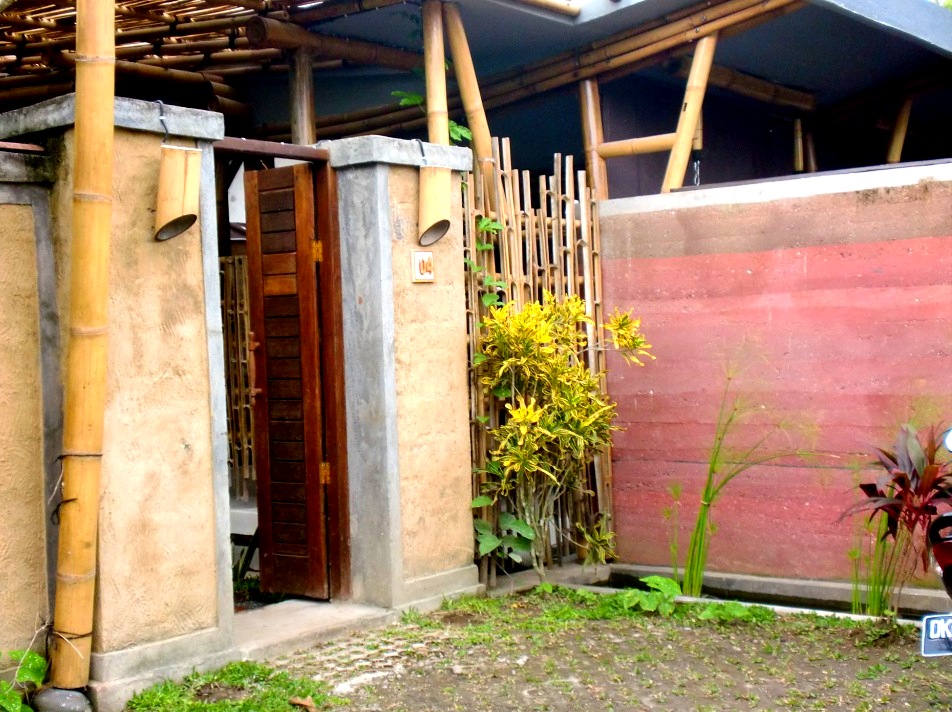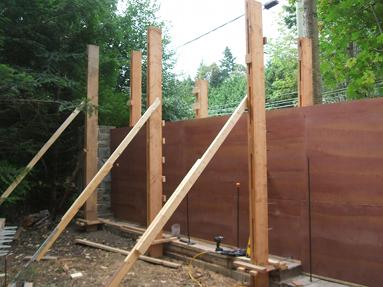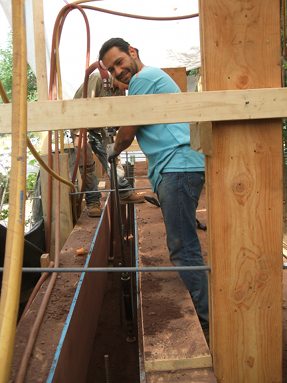By Clifton Schooley
Beautiful, comfortable, durable and sophisticated are some of the words that can be used to describe a well built rammed earth house. Millions of people have enjoyed the benefits of living in this kind of home over the course of the last 2000 years. When people who are unfamiliar with this type of building hear about them they usually have some incorrect presumptions about them. Ideas swirl in their head about what it looks like and doubt its ability to make a good building or confuse them with other types of mud houses. So what is it? Rammed earth walls are structural masonry walls that are made of a compacted mixture of gravel (stone), sand and a small percentage of silt and clay. By adding cement to the mix, stabilized rammed earth (S.R.E) walls are created that perform similarly to concrete walls but are infinitely more beautiful. The finished walls are typically thick (50-60cm) and have a sedimentary layered look due to the compaction of materials in layers during the construction process. The texture of the walls can vary and are similar to sandstone but with both smooth ad rough areas with exposed gravel at times. When using S.R.E it is easily possible to make walls that can support the weight of multiple stories above. With the addition of steel reinforcing S.R.E walls can be used in earthquake zones with performance levels equal to or better than reinforced concrete buildings.
Most of the worlds rammed earth homes are found in non-tropical areas, possibly due to the abundance of wells suited materials in certain locations. Having a local history and skilled people to make these building are key factors in determining where certain types of buildings are located, it boils down to knowledge usually. But what about rammed earth in tropical areas? It turns out that they are a very good idea in these types of climates. Rain, wind, heat, insects and rodents are no match for good S.R.E. walls. Maintenance is almost non-existent because the durability of this material. What about finding suitable raw material to build with? Due to the volcanic nature of many tropical areas the right subsoil may not be available under the ground near your building site. Luckily it is possible to blend materials together, for example: volcanic gravel and sand blended with a small quantity of silt and clay. After the raw materials are mixed some cement and color can be added. What about cost? On a long term basis S.R.E walls usually be cheaper because of the durability when you factor in long term costs. Bricks and concrete blocks offer a cheaper up front cost. They also require plastering and maintenance and almost always end up looking quite ugly due to separation of materials and peeling paint due to the local climate.
– See more at: www.greenasiaforce.com/rammed-earth-homes-in-the-tropics
Here are a few do’s and don’ts when considering building a rammed earth home:
- Do find a good designer/architect that is open minded to new things. Previous experience is great but not necessary if they can adapt to a new method of building and designing. Have them work with a consultant or someone with experience in S.R.E. construction. Don’t find a designer/architect and have them design the house and then bring it to your consultant or builder for their review, that will waste time and money redesigning for cost effective construction. Do things right from the beginning.
- Do find an experienced R.E. builder that will build your home for you and maybe even allow you to participate in the construction if you wish. This will save time, money and frustration of having to try with trial and error. Don’t try to DIY(do it yourself) without proper training, like anything skill is related to quality of the finished product. I’ve been amazed by the volume of inaccurate information on the internet, which is where most DIY’ers find their guidance. There is no substitute for a skilled tradesman.
– See more at: http://www.greenasiaforce.com/rammed-earth-homes-in-the-tropics/#sthash.RXuepsZO.dpuf
One of the great things about rammed earth homes is that they are built to last, something that can be passed from generation to generation, now that’s environmental! Living in a rammed earth home is a also a rewarding experience. Of course the building looks beautiful and solid but the feeling is an intangible quality. The walls have a presence, a depth to them, they feel…more earthly than most buildings. We tend to make a lot of our decisions based on emotion but currently most of the homes most of us have been living in leave us unsatisfied. There has been a lack of alternative and boring monocultures of houses to choose from. We are moving into a time of greater choice for homes that we can feel good in and a rammed earth home is worth considering.
By Clifton Schooley
Clifton is a green building professional specializing in rammed earth construction and design in Canada and worldwide. His vision is to create environments that are beautiful, artistic and sustainable. Clifton believes that both design and construction of a building must be intimately connected to bring maximum benefit to both people and the environment. Beyond rammed earth his ambition is to become an eco-developer and influence society on a larger scale.
Clifton will be teaching a workshop on rammed earth walls in Thailand later this year.




